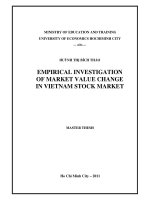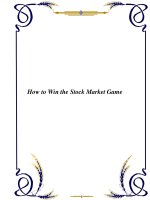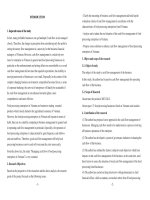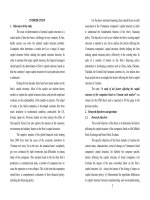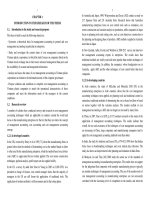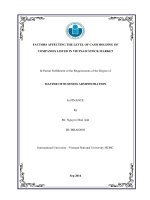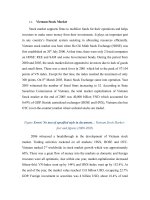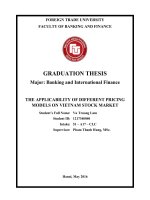Vietnam stock market
Bạn đang xem bản rút gọn của tài liệu. Xem và tải ngay bản đầy đủ của tài liệu tại đây (437.14 KB, 7 trang )
1.1.
Vietnam Stock Market
Stock market supports firms to mobilize funds for their operations and helps
investors to make more money from their investments. It plays an important part
in any country’s financial system assisting in allocating resources efficiently.
Vietnam stock market was born when Ho Chi Minh Stock Exchange (HOSE) was
first established on 20th July 2000. At that time, there were only 2 listed companies
on HOSE: REE and SAM and some Government bonds. During the period from
2000 and 2005, the stock market did not appealed to investors due to lack of goods
and small firms. There was a stock fever in 2001 which led to the peak of 571.04
points of VN index. Except for that time, the index reached the maximum of only
300 points. On 8th March 2005, Hanoi Stock Exchange came into operation. Year
2005 witnessed the number of listed firms increasing to 32. According to State
Securities Commission of Vietnam, the total market capitalization of Vietnam
Stock market at the end of 2005 was 40,000 billion VND which accounted for
0.69% of GDP. Beside centralized exchanges (HOSE and HNX), Vietnam also has
OTC (over-the-counter) market where unlisted stocks are traded.
Figure Error! No text of specified style in document..: Vietnam Stock Market fact and figures (2000-2005)
2006 witnessed a breakthrough in the development of Vietnam stock
market. Trading activities rocketed on all markets: HNX, HOSE and OTC.
Vietnam ranked 2nd worldwide in stock market growth which was approximately
60%. There was a great flow of money into the markets as domestic and foreign
investors were all optimistic. Just within one year, market capitalization increased
fifteen-fold. VN-Index went up by 144% and HNX-Index went up by 152.4%. At
the end of the year, the market value reached 13.8 billion USD, occupying 22.7%
GDP. Foreign investment in securities was 4 billion USD, about 16.4% of total
market value. VN-Index achieved a record of 809.86 points while HNX-INDEX
rose to 260 points.
On 11 January 2007, Vietnam officially joined World Trade Organization
(WTO). The event considerably influenced stock market. The peak of over 1,170
points of VN-Index was reached and HNX-Index had the highest of 459.36 points
in 2007 during when the market broke out. The effectiveness of regulation on
stock market on 1st January 2007 encouraged growth of the market and gave
foreign investors opportunities to join Vietnam equity market. There was a
considerable fluctuation in prices during trading sessions this year. In the final
session of the year, VN-Index reached 927.02 and HNX-Index reached 323.55
points.
2008 was an unsuccessful year for the stock market. The major reason is
due to global recession. Housing bubble collapsed in the United State followed by
financial market then crisis spread to the whole US economy and other countries
including Vietnam. Foreign investors withdrew money out of Vietnam equity
market as well as other frontier market. By contrast, Vietnamese government
motivating privatization, especially large and efficient corporations and secondary
offerings of many stocks and bonds led to excess supply. All resulted in low
liquidity and reduce in market price (even below par value). Generally speaking,
2008 could be divided into 3 phases: For the first half of the year, market was
downward as strongly affected by macroeconomic conditions. June to September
was the phase of short-term recovery. In the last three months, market went back
to long recession.
The following year experienced an impressive recovery of stock market.
During 2009, VN-Index rose by 171.96 points, from 312.49 to 494.17 equal to
58%. Similarly, index in HNX increased by 60.9%. If comparing the bottom of
78.06 points to the highest of 218.38 in the year, the index went up almost 3 times.
Also in June 2009, Hanoi Stock Exchange (HNX) launched UPCOM (Unlisted
Public Company Market). UPCOM is the place at which stocks and convertible
bonds of public firms which is not listed on centralized exchanges are traded.
Moreover, UPCOM-Index was introduced as a useful tools for investors to get an
overview of prices in UPCOM market. From 10 companies initially, UPCOM has
well-developed and until 31th December 2011 it contained 131 firms. UPCOM is
considered a safe playground for investors who wish to avoid risks in grey market
and it plays as an important part in the process of creating a modern OTC market
in Vietnam.
Figure Error! No text of specified style in document..: UPCOM-Index (20092015) (Source: Bloomberg)
In 2010, prices of most stocks declined. End of the year, VN-Index closed
at 484.66, decreasing by 2% while HNX-Index closed at 114.24, decreasing by
32.3% in comparison with 1st January. The reason was that the economy became
unstable due to inconsistent decisions of the Government on fiscal policies aiming
to control inflation rate and interest rate race between commercial banks. Stock
market did not recover until November. For the first time there was market
manipulation activities existing in Vietnam stock market. Furthermore, merge and
acquisition (M&A) activities also increased in number during the year.
At the beginning of 2011, the central bank adjusted exchange rate to
increase by 9.3% and inflation rate shot up in February. These factors caused
equity market to plunge. After a short time increasing from August to September,
market indexes continued to dropped since domestic economy was still gloomy
and influenced by the pessimistic global economy when public debt in Europe was
not solved. Compared to the beginning of the year, end-of-year VN-Index dipped
by 27.46% while HNX-Index even fell by over 48%. The value of a session on
each exchange went down by approximately 60% relative to the previous year.
While 2011 was not remembered as a satisfactory year of stock market,
2012 was a remarkable year. In the first five months, both VN-Index and HNXIndex rose by above 40%. Unfortunately, in the second half of 2012, the upward
trend in stock market reversed as the financial system faced some difficulties. The
percentage of non-performing loans in the debt structure of banks increased
sharply which made firms could not approach funds from commercial banks
although interest rates fell greatly. As no fund was mobilized, businesses was
unable to keep on operating normally. Stock prices decreased reflecting
disappointment of investors in companies’ prospect. This also led to losses of
securities companies during this period. As reported, there were 50 percentage of
securities firms suffered from losses. Moreover, heads of some large bank were
arrested and investigated which damaged reputation and made bank stocks
plummeted. Therefore, for the first time in history, HNX-Index reached the bottom
of 50.33 points, decreasing by 36% while VN-Index decreased by 20%.
Turn to 2013, the economy was much more stable when government
policies worked: Inflation rate was held back and IIP (Index of Industrial
Production) increased by 5.6% comparing with same period last year. Meanwhile
foreign exchange market did not fluctuate and foreign currency reserves increased.
Besides, adjustments such as decrease in taxes on stock transfer, market order
application, extension of trading time and increase in margin had positive effects
on stock market. VN-Index and HN-Index rose 23% and 13% respectively relative
to the end of 2012. Market capitalization was 964 trillion VND (199 trillion VND
higher than last year) which occupied 31% of GDP. Furthermore, State Securities
Commission of Vietnam also allowed for the foundation of open-ended funds.
There were 10 open-ended funds open this year: Vina Wealth funds, MBBF,
BFED, VCBF…
The growth rate of Vietnam in 2014 was 5.9% which was higher than the
target rate due to increase in exports. Interest rate fell benefitting businesses.
Although there were some unexpected events like high intension in Bien Dong,
sharp decrease in oil price, stock market still saw a positive picture. VN-Index hit
the top of 640.75 again after 6 years on 3 rd September while HNX-Index had the
highest of 92.99 points on 24th March after 3 years. Up to 8th December 2014, VNIndex went to 571.68, increasing by 13.3% and HNX-Index reached 87.17,
increasing by 28.5% in comparison with last day of 2013. On 4 th July, the first
domestic exchange traded fund (ETF) called E1VFMVN30 was born which
mimics HSX30 with the scale of 202 billion VND. Three months later, the second
ETF imitating HNX30 was permitted to be offered to investors. This was a chance
for investors who prefer passive investment strategy to participate in the market.
Foreign investors could use these ETFs as an indirect tool to invest in stocks that
they cannot own directly. Moreover, this year, a project for constructing and
developing derivatives market in Vietnam was approved marked a next step in the
development of Vietnam financial market in the near future.
Figure Error! No text of specified style in document..: VN-Index (2000-2015)
(Source: Bloomberg)
Above all, after 15 years in operation, the biggest contribution of Vietnam
stock market is help to create successful businesses with strong support from a
channel supplying an unlimited source of funds. Even though it cannot be denied
that Vietnam stock market does have weaknesses (the existence of manipulation,
insider trading, etc.), it is obviously an essential place where businesses can
mobilize funds in medium and long term other than bank loans which can be
costly for small firms.
By privatizing state-owned enterprises and listing them on centralized
exchanges as well as issuing Government bonds annually since September 2009,
stock market has assisted banks in mobilizing a great amount of funds for
Government and businesses. According to Ho Chi Minh Stock Exchange, until
now there are 307 stocks, 2 close-ended funds, one exchange traded fund (ETF)
and 38 bonds listed. The total value of market capitalization on HOSE were 985
trillion VND in the end of 2014, accounting for 88% of market value in the whole
stock market. It also made up 25% of Gross Domestic Product (GDP) in 2014.
Especially, domestic stock market plays an integral part by supporting
Vietnamese corporations in approaching international financial markets. It also
attracts foreign financial institutions to join Vietnam stock market. A number of
certificates have been issued in foreign currencies (foreign bonds) to sell in other
financial markets. By doing this, stock market becomes a channel where funds
from foreign institutional investors can flow into the economy. Also in reverse,
Vietnamese investors are able to find safe and efficient investment in other
economies.
In fact, although firms listed in stock market come under pressure when
they have to publish all information about their operations to all investors as well
as have outside auditors auditing their financial statements semiannually or
annually, this is, however, a motivation for firms to run efficiently. Through stock
market, firms not only attract funds with low costs but also find some big
international investors who can help them gain more experiences in governance,
administration and operation based on international standards.
A number of typical companies successful with the help of Vietnam stock
market that could be mentioned are: Vinamilk (VNM), Kinh Do (KDC), Hau
Giang Pharma Corp. (DHG), PNJ, Saigon Securities Inc. (SSI), Tien Phong Plastic
Company (NTP)… They usually increase equity through market to upgrade
machines, update the latest technology and expand their factories.
Figure Error! No text of specified style in document..: Number of listed firms on
Vietnam Stock Market throughout history
